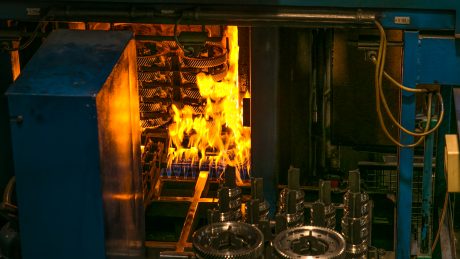*/
]]>
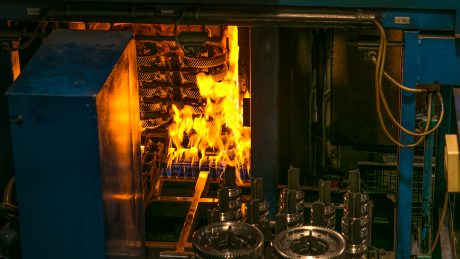
View from above of the automatic loading of the pusher.
Hardening processes
At the end of the soft manufacturing line, the parts are placed on the grates.
F 17 gears get into the pushers and are heated there with natural gas to 875 ° C (operating under carrier gas atmosphere, carbon addition in the form of methane gas).
M3x parts and F17 gear blocks are hardened in the vacuum furnaces: by pumping down to a defined negative pressure, a vacuum is created in the furnaces, after which the furnaces are electrically heated up to 970 ° C and carbon in the form of propane gas in the heating cell blown.
The parts heated in the pusher are quenched in an oil bath; then the oil is washed off in washing machines.
The parts heated in the vacuum furnaces are quenched with nitrogen in separate quenching cells up to 15 bar.
On the induction hardening plants, the sliding gear and the 3rd / 4th gear shift sleeves and the 5th gear shift sleeve are inductively heated to 860 ° C and quenched on a hardening mandrel with an aqueous solution. The advantage of this method is that the thin-walled components can be hardened with very little delay.
In the solidification blast machines, the gear parts are bombarded with steel balls (about 0.6 mm in diameter) to strengthen the surfaces even more.
Subsequently, the gear parts in the tempering ovens are heated again for up to 170 ° C for about four hours in order to release the stresses created during hardening inside the parts.
A car driver shifts the gears thousands of times a year – a good gearbox has to stand it easy. Especially the gears and the gear block. These are therefore cured in the hardening shop; in complex thermo-chemical processes. By heating up to 970 ° C and subsequent quenching so that they end up with up to 800 HV surface hardness and up to 50 HRC core hardness.
After hardening, some of the components are additionally solidified with small steel spheres, so that the components are solidified to a compressive residual stress of up to 1200 MPa at the surface. (In shot peening blasting, compressive residual stress is introduced into the component, increasing fatigue strength.)
The trick: the hardness of the parts should be as low as possible.
The Asperner hardening team does this: “We have never had a warranty claim due to a poorly hardened component,” says Robert Schertler / Härterei-Leiter proudly. And points to additional challenges for the Asperner hardening shop: extremely large quantities to be hardened, each consisting of 14 different components for F 17 and M3x gearboxes.
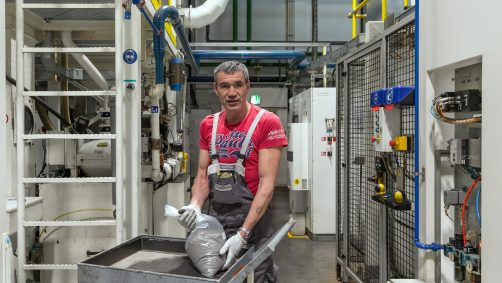
Filling a hardening blasting machine (in the picture Josef Weber).
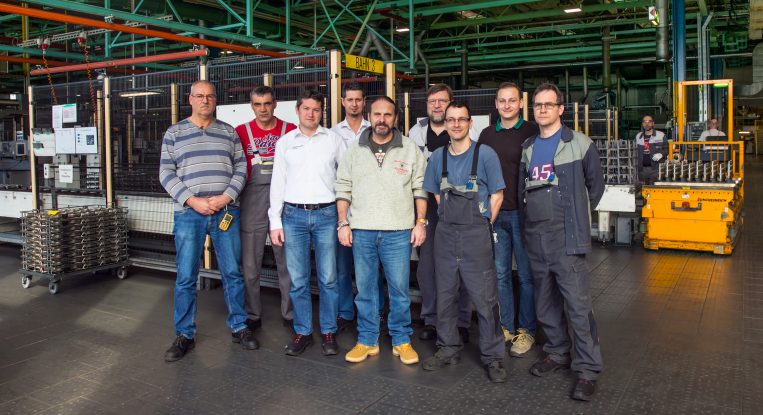
The team of Härterei (v.l.n.r.): Walter Weilinger, Josef Weber, Robert Schertler, Rainer Binder, Roland Stettina, Reinhold Riener, Markus Geissler, Thomas Künzel, Christian Anderlik.
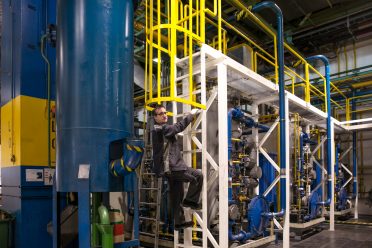
Maintenance platform at the endomats (in the picture Christian Anderlik).
Maintenance tinkerer
Another challenge can be seen from the numerous improvement measures taken in recent years: The systems used to harden F 17 gearbox parts are on average over 25 years old, the remaining systems (for hardening the M3x gearbox parts) about 15 years.
The Härterei team is therefore almost constantly striving to implement improvements that ensure the trouble-free operation of the hardening shop: From 2012 to 2016 – apart from the normal maintenance activities – all 30 casings of the five M3x vacuum furnaces were replaced (ie the inner lining made of graphite insulation sheets). renewed the control of one of the three F 17 pusher furnaces (2016), in order to gain spare parts for the controls of the other pusher furnaces in the same way. A control exchange was also carried out on a vacuum furnace for F 17 components.

Loading the linkage for the pusher furnace (Dieter Gürschka).
For the stacking grids on which the parts are placed, which automatically retract into the pusher ovens or vacuum furnaces, a new solution has been developed: Due to the high temperatures, the grids distort or sometimes even break. Since the beginning of 2016, a Härterei employee has been shut down to repair the nickel-containing grids by aligning, cutting, welding and grinding. This can extend the life of the hardener rust. That’s cheaper. Throw away the grates and buy new ones immediately.
Save energy and keep an eye on work safety
Four compressors supply the M3x solidification radiators with compressed air. In February 2018, they were merged and implemented a higher-level control, so now – depending on demand – compressor can be switched to compressor. This contributes to energy savings.
Energy saving are also LED lights. At the end of 2017, the hardening shop was the first area in the Vienna-Aspern plant, which was converted to LED lighting by the plant area. “That also contributes to energy savings, since we work in three shifts,” says Robert Schertler.
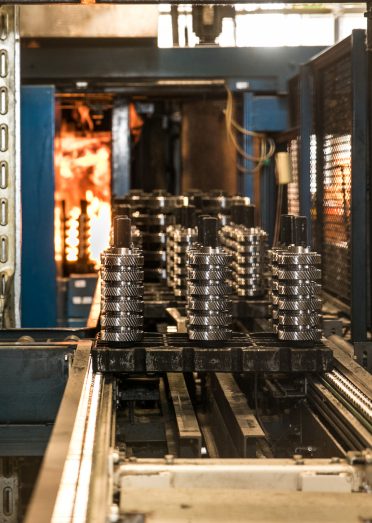
Automatic loading of the pusher.
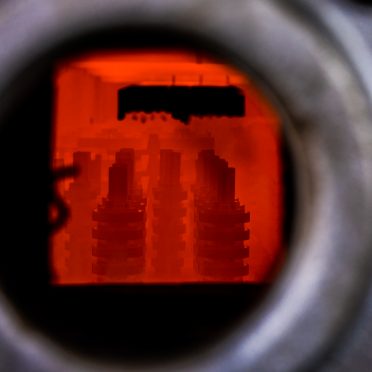
View into the interior of a pusher
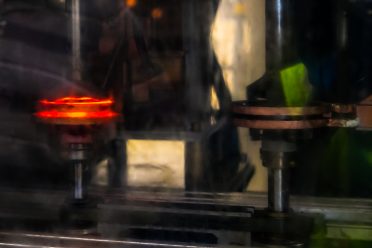
Inductive heating of the sleeves in the induction hardening plant
To improve safety at work, a maintenance platform has been set up at the ATMs (and completed during the plant holidays in 2017), so that employees can work ergonomically optimized when controlling the valves and during maintenance work on the carrier gas production plants. In addition, at the beginning of 2017, fall protection systems were implemented in the entire hardening shop.
Ready for the future
The hardening team is not only concerned with ensuring ongoing operations: Design changes affecting the material have an impact on the production processes in the hardening shop. In April 2016, for example, the hardening process for the second gear of the F 17 gearbox was changed: Since then, the parts in question have been hardened in the pushers instead of the vacuum furnaces, as before.
Even more important are the preparations for future tasks: In May 2017, an old blast furnace was demolished to make room for new hardening tasks. During the plant holidays in 2016, a new hardening blasting plant was implemented. It will soon be used for a new project.
Hardening plants
For F 17 gear units: 3 pushers, 3 vacuum furnaces, 3 induction hardening units, 1 plaster blasting unit, 2 hardening blasting units, 1 hand blasting unit, 4 tempering furnaces, 3 washing machines, 4 endomats (they generate carrier gas for the pusher furnaces)
For M3x gear units: 5 vacuum furnaces, 4 solidification blast machines with compressed air, 1 hardening blast machine with blast wheel
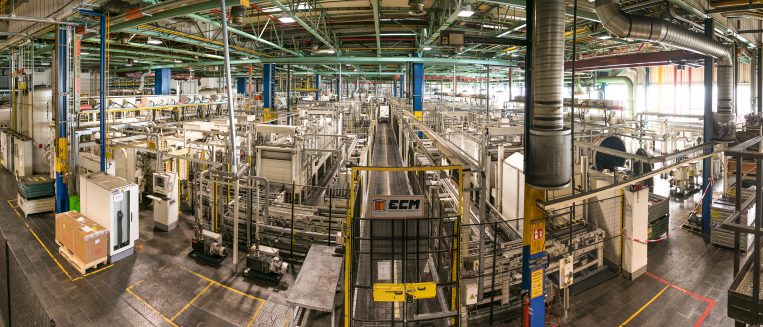
View of the vacuum furnaces for M3x gearboxes in the hardening shop.
Text: Kristin Engelhardt, Photos: Helga Mayer
